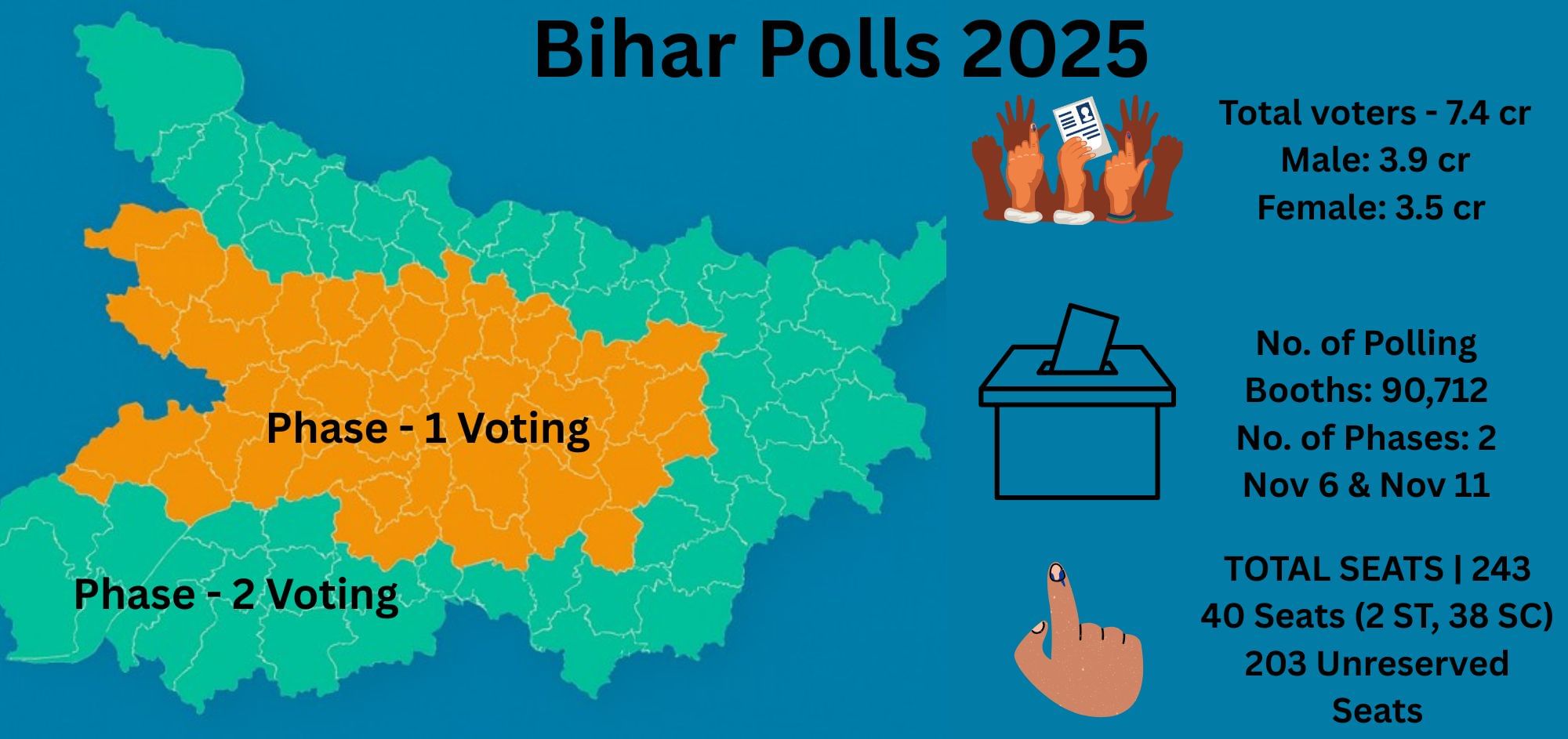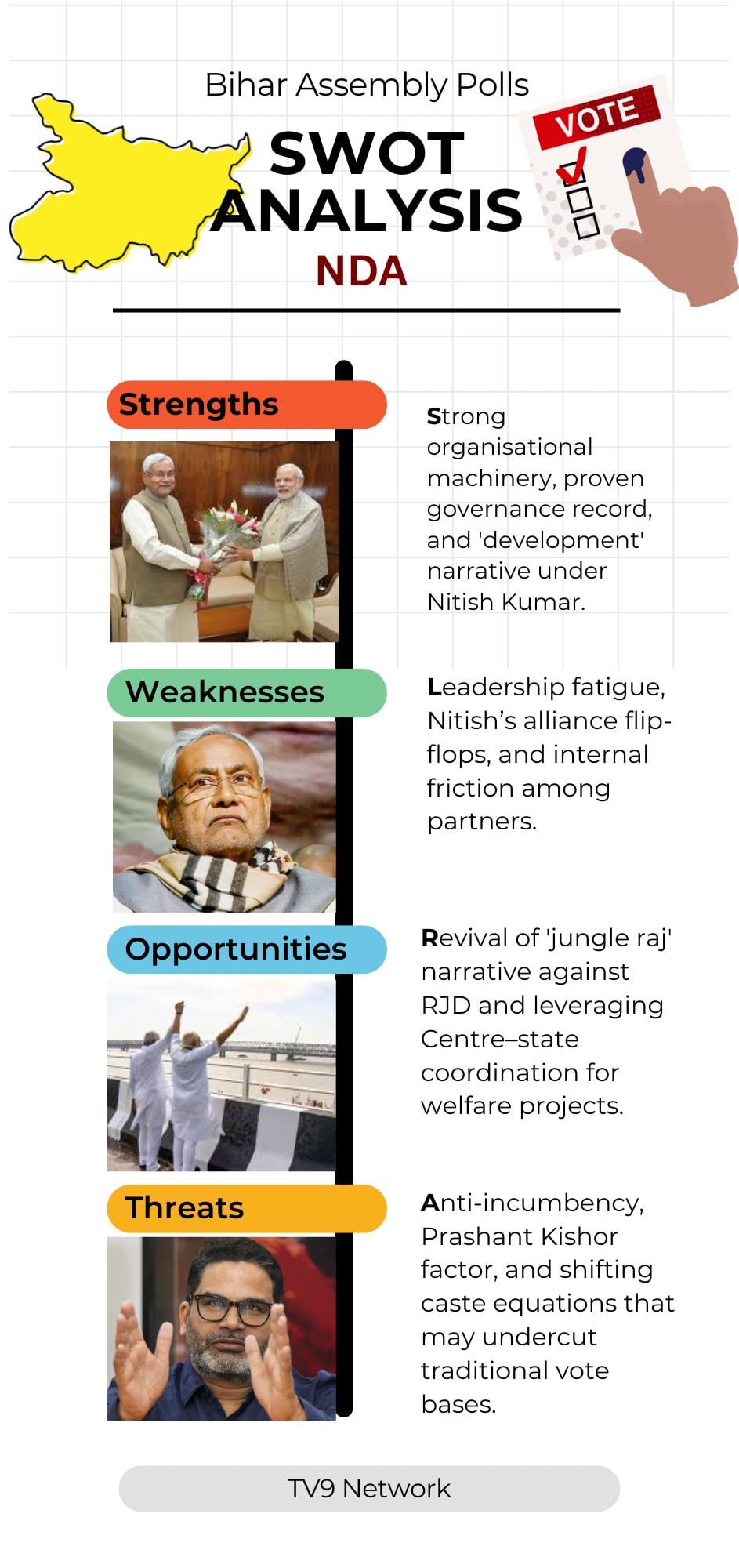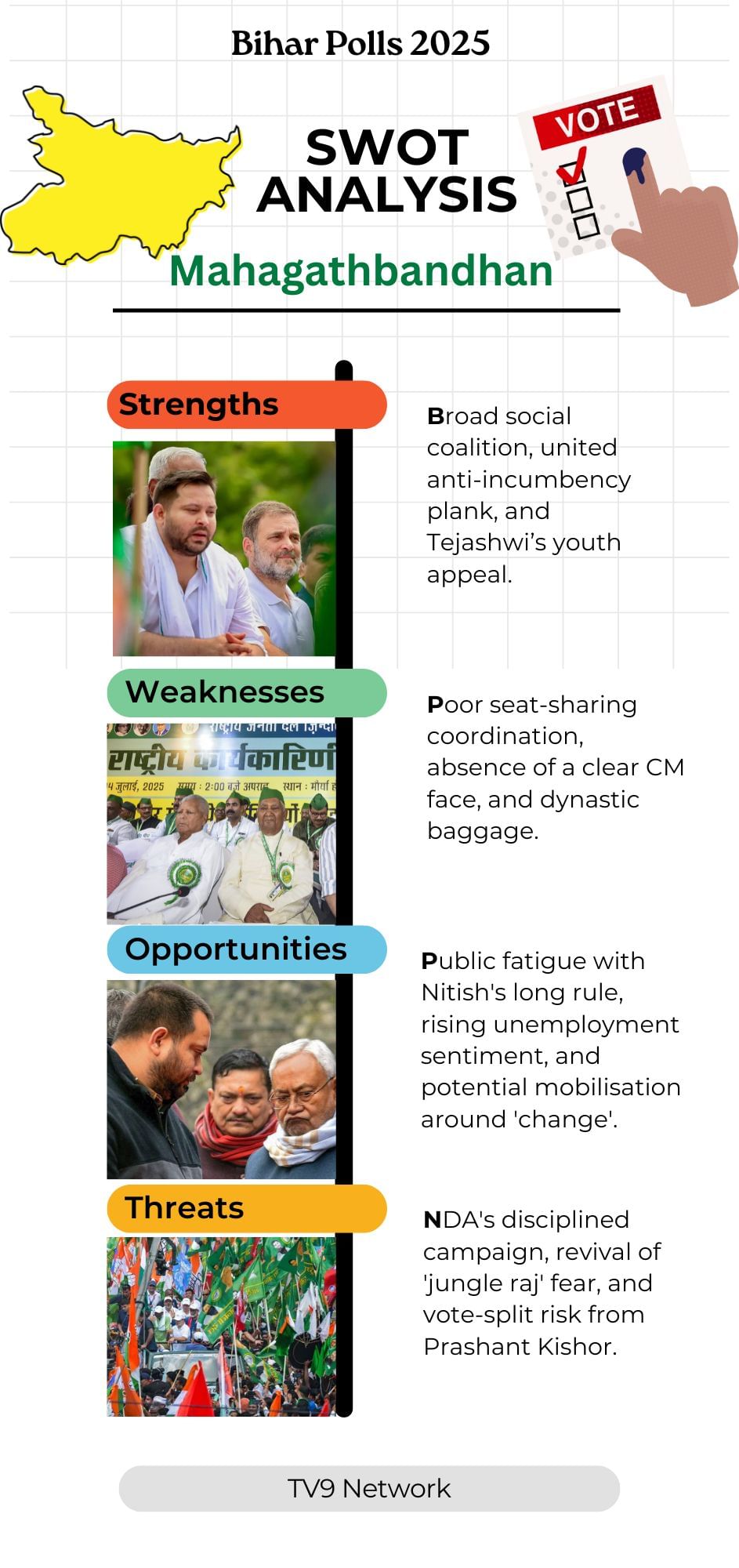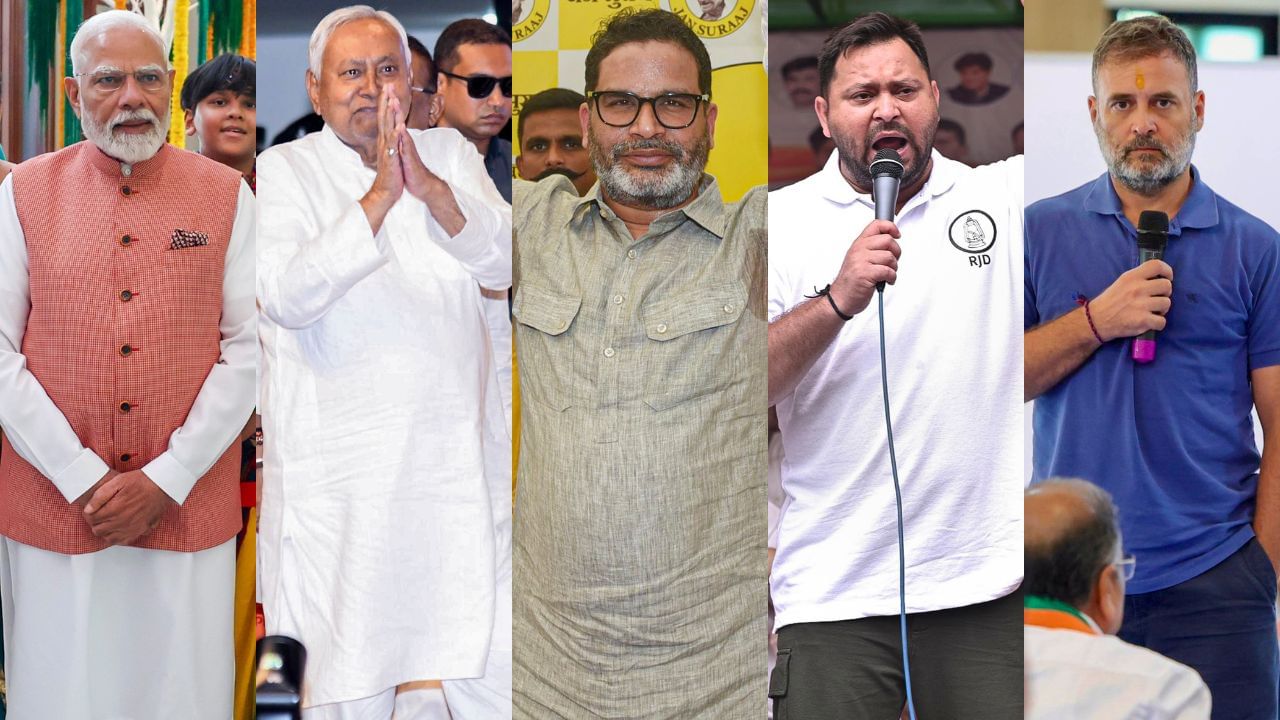New Delhi: Hours after the Election Commission announced the Bihar poll schedule, the state’s political battle lines were drawn. Former deputy chief minister and Rashtriya Janata Dal (RJD) leader Tejashwi Yadav said Bihar was “eager for change”, while Union home minister and senior (Bhartiya Janata Party) BJP leader Amit Shah asserted that voters would once again choose the “politics of development”.
The contrasting statements capture the core themes of the last state elections of 2025 — change versus continuity. Bihar will vote in two phases on November 6 and 11, with counting on November 14.

NDA: Banking on development, balancing contradictions
Nitish Kumar-led NDA will hope to not only repeat its 2020 performance but improve upon it. The love and hate relationship between the various constituents of the alliance will be closely watched in the runup to the polls. A well coordinated campaign and common minimum programme will be crucial for the outcome of the alliance. The NDA currently comprises five parties — the BJP, JD(U), Lok Janshakti Party (Ram Vilas), Hindustani Awam Morcha (HAM), and Rashtriya Lok Morcha (RLM).
Here are four key factors that could shape the NDA’s prospects in the upcoming polls.
1. Coordination
Senior NDA leaders have clarified that the election will be fought under Nitish Kumar’s leadership, but whether he retains the CM face if the alliance wins will depend on post-poll arithmetic. LJP leader and Union minister Chirag Paswan — not part of the NDA in 2020 — is again a factor to watch, not least for Nitish himself.
In 2020, Chirag’s party contested separately, fielding candidates against JD(U) nominees and hurting its prospects. His slogan “Modi se bair nahi, Nitish teri khair nahi” became a viral war-cry that dented JD(U)’s image and cut its tally to 43 seats. It would be interesting to see how these parties will campaign and work together.
2. Seat sharing
While nothing official has emerged yet, reports suggest JD(U) may contest about 102 seats, BJP 101, and the smaller allies the remaining 40. In 2020, JD(U) contested 115 seats and won 43 with 15 per cent of the vote, while the BJP won 74 of the 110 it fought.
HAM chief and Union minister Jitan Ram Manjhi is seeking at least 15 constituencies, and RLM chief Upendra Kushwaha around a dozen. LJP too would demand a substantial seats after its below par performance in 2020 assembly elections where it was limited to just 1 seat.
3. Anti-incumbency
Having governed almost continuously since 2005, Nitish Kumar faces the challenge of convincing voters that he remains the right choice. While his party’s good showing in the 2024 Lok Sabha polls reinforced his relevance to the NDA, fatigue and questions over his health persist. Neither the BJP nor the RJD has so far managed to form a government in Bihar without Nitish as ally — a reminder of his enduring political weight.
Once a formidable force in Bihar, Nitish it seems losing his grip over the state politics with his allies over the years be it RJD or BJP calling most of the shots. There are also concerns that he is taking the voters for granted. In 2020, his slogan “Kyoon karen vichar, theek to hai Nitish Kumar” (Why think about it, Nitish Kumar is doing just fine) didn’t sit well with voters with opposition taking potshots at him.
Even for BJP it would be a herculean task to convince the voters that the NDA is the right fit for them and the state. What works for BJP is that since 2013 it was not continuously part of the ruling coalition, the same cannot be said about Nitish Kumar.
4. Nitish’s flip-flops
Nitish’s repeated switches between alliances add another layer of uncertainty. He first broke with the NDA before the 2014 general election to join Lalu Prasad Yadav’s RJD and the Congress, winning handsomely in 2015. In 2017, citing corruption cases against RJD leaders, he returned to the NDA. In 2022, alleging attempts by the BJP to split his party, he walked out again — only to re-enter the NDA ahead of the 2024 Lok Sabha polls.
Though he now insists he will “never leave the NDA again”, allies remain wary. For the BJP, Nitish is still indispensable in Bihar — as is Chirag Paswan — which means he is likely to remain the CM face even if JD(U)’s seat share dips further.
The opposition will likely tell voters that Nitish can’t be trusted. While the CM might tell the people that he did all to work for the development of Bihar, his regular political summersaults might send a negative feedback to voters.

Mahagathbandhan: United in rhetoric, divided in strategy
As the NDA works to retain power, the opposition Mahagathbandhan faces its own test of coordination and credibility. The alliance currently includes six parties — RJD, Congress, CPI, CPI(M), CPI(ML-L) and Vikassheel Insaan Party (VIP) — with the Rashtriya Lok Janshakti Party (Paras faction), Jharkhand Mukti Morcha (JMM) and Indian Inquilab Party (IIP) expected to join soon.
1. Coordination
During Rahul Gandhi’s Vote Adhikar Yatra, the coalition projected unity, but murmurs of senior Congress leaders being sidelined at key events persist. Tejashwi Yadav has repeatedly declared himself the alliance’s chief-ministerial candidate, yet the Congress has withheld endorsement. Even Rahul Gandhi avoided naming a CM face during his Bihar tour.
Congress in-charge Krishna Allavaru has said the next CM will be decided by the voters and the elected MLAs — signalling the party’s reluctance. The Congress it seems wants leverage in seat-sharing, worries that Tejashwi’s corruption cases could taint its image, and fears that backing a Yadav leader may alienate OBC and EBC voters it hopes to attract.
What works for the alliance is that most of its constituents are part of it for a longer period of time and already has a common minimum programme.
2. Seat sharing
With multiple partners, talks are proving difficult. Reports say RJD has offered 12 seats to Mukesh Sahani’s VIP, six to CPI and four to CPI(M). No deal yet with CPI(ML), which wants 40, or with Congress. RJD, which contested 144 seats in 2020, does not wish to drop below 130, leaving 113 for the others.
In 2020, Congress contested 70 seats and won 19. Many in RJD believe its poor strike rate cost the alliance power. The Congress may settle for about 60–62 seats this time but could bargain for key portfolios if the coalition wins.
3. The ghost of ‘jungle raj’
The “jungle raj” label remains potent even after two decades, symbolising the fear and misgovernance associated with the Lalu-Rabri years. The BJP and JD(U) continue to use it as a political weapon to warn voters against the return of that period, especially younger voters who have only heard stories of it. Every time issues of crime, corruption, or political control arise, opponents revive the term to question the RJD’s credibility.
The matter resurfaced in February 2025 when Subhash Yadav, Lalu’s brother-in-law, claimed that kidnapping cases were handled from the chief minister’s residence, sparking a big political row and putting the RJD in trouble once again.
For the NDA, “jungle raj” isn’t just history — it’s a campaign narrative linking the RJD’s past with the state’s future stability.
4. Dynastic politics
Congress and RJD both face dynastic baggage. The NDA has made it a central attack line after RJD fielded Lalu’s daughter Rohini Acharya in the 2024 Lok Sabha polls — the fourth of his children to contest after Tejashwi, Tej Pratap and Misa Bharti.
Nitish Kumar recently claimed that during RJD’s rule, “Lalu cared only for his family, not the people of Bihar.” Even PM Modi during one of his rallies in Bihar earlier this year said, “We say ‘Sabka saath, sabka vikas’ but the RJD and Congress believe in ‘parivaar ka saath, parivaar ka vikas’.”
The opposition will be watching closely if Nitish Kumar fields his son in assembly polls, if he does so, it would blunt the NDA’s narrative of dynastic politics or nepotism.

The outsider: Prashant Kishor’s Jan Suraaj factor
In an interview with TV9 Bharatvarsh, election strategist–turned–politician and Jan Suraaj founder Prashant Kishor declared that Bihar’s political status quo is ending. “For 30 years, Nitish Kumar and the BJP told people to vote for them or face ‘jungle raj’, while Lalu Prasad’s camp warned of communal forces. The public kept voting out of fear. Now, they finally have a new option,” he said.
While the party is yet to finalise how many seats it will contest, Kishor has confirmed that Jan Suraaj will enter the fray, with a candidates list expected later this week.
Many question Kishor’s ability to break through Bihar’s deeply entrenched caste-driven politics, but his clean-image appeal and focus on governance resonate with younger and first-time voters looking for an alternative to the two dominant blocs.
Kishor remains bullish about his prospects. “Last time, both alliances together got 72 per cent of the vote. A third of voters didn’t support either side. Even if you cut 5 per cent from each alliance and add it to the 28 per cent, Jan Suraaj will take enough votes to make both lose,” he told TV9.

Many analysts have questioned Kishor’s ability to break through Bihar’s deeply entrenched caste-driven politics
The road ahead for NDA and Mahagathabandhan
The NDA’s strength lies in its proven development record and organisational machinery, but anti-incumbency and internal friction could test its cohesion. The Mahagathbandhan offers the promise of change, yet faces questions of leadership, coordination and credibility.
Both alliances will also be wary of shifting caste equations, where a candidate with a strong community base can upend even a formidable opponent.
The November verdict will decide whether Bihar opts for continuity under Nitish Kumar or a generational shift led by Tejashwi Yadav — in essence, whether the state still believes in “vikas” or yearns for “badlaav”.
